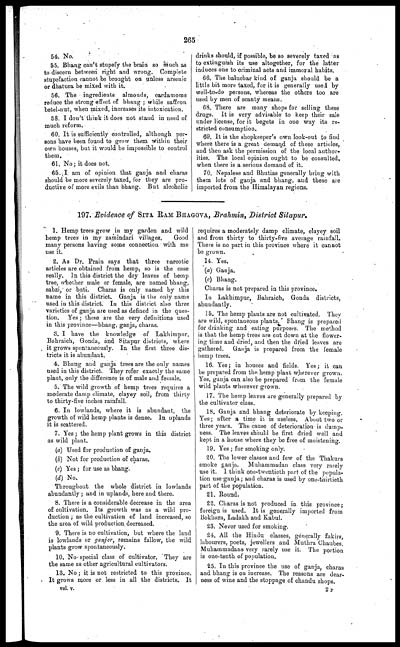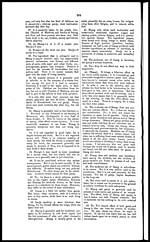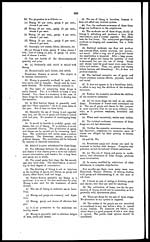Medicine - Drugs > Report of the Indian Hemp Drugs Commission, 1894-1895 > Volume V
(285) Page 265
Download files
Individual page:
Thumbnail gallery: Grid view | List view

265
54.No.
55.Bhang can't stupefy the brain so much as
to discern between right and wrong. Complete
stupefaction cannot be brought on unless arsenic
or dhatura be mixed with it.
56.The ingredients almonds, cardamoms
reduce the strong effect of bhang ; while saffron
betel-nut, when mixed, increases its intoxication.
58.I don't think it does not stand in need of
much reform.
60.It is sufficiently controlled, although per-
sons have been found to grow them Within their
own houses, but it would be impossible to control
them.
61.No ; it does not.
65.I am of opinion that ganja and charas
should be more severely taxed, for they are pro-
ductive of more evils than bhang.But alcoholic
drinks should, if possible, be so severely taxed as
to extinguish its use altogether, for the latter
induces one to criminal acts and immoral habits.
66.The baluchar kind of ganja should be a
little bit more taxed, for it is generally used by
well-to-do persons, whereas the others too are
used by men of scanty means.
68.There are many shops for selling these
drugs. It is very advisable to keep their sale
under license, for it begets in one way its re-
stricted consumption.
69.It is the shopkeeper's own look-out to find
where there is a great demand of these articles,
and then ask the permission of the local author-
ities. The local opinion ought to be consulted,
when there is a serious demand of it.
70.Nepalese and Bhutias generally bring with
them lots of ganja and bhang, and these are
imported from the Himalayan regions.
197.Evidence of SITA RAM BHAGOVA, Brahmin, District Sitapur
1.Hemp trees grow in my garden and wild
hemp trees in my zamindari villages. Good
many persons having some connection with me
use it.
2.As Dr. Prain says that three narcotic
articles are obtained from hemp, so is the case
really. In this district the dry leaves of hemp
tree, whether male or female, are named bhang,
sabzi, or buti. Charas is only named by this
name in this district. Ganja is the only name
used in this district. In this district also three
varieties of ganja are used as defined in the ques-
tion. Yes ; these are the very definitions used
in this province—bhang, ganja, charas.
3.I have the knowledge of Lakhimpur,
Bahraich, Gonda, and Sitapur districts, where
it grows spontaneously. In the first three dis-
tricts it is abundant.
4.Bhang and ganja trees are the only names
used in this district. They refer exactly the same
plant, only the difference is of male and female.
5.The wild growth of hemp trees requires a
moderate damp climate, clayey soil, from thirty
to thirty-five inches rainfall.
6.In lowlands, where it is abundant, the
growth of wild hemp plants is dense. In uplands
it is scattered.
7.Yes ; the hemp plant grows in this district
as wild plant.
(a)Used for production of ganja.
(b)Not for production of charas.
(c)Yes ; for use as bhang.
(d)No.
Throughout the whole district in lowlands
abundantly ; and in uplands, here and there.
8.There is a considerable decrease in the area
of cultivation. Its growth was as a wild pro-
duction ; as the cultivation of land increased, so
the area of wild production decreased.
9.There is no cultivation, but where the land
is lowlands or ganjer, remains fallow, the wild
plants grow spontaneously.
10.No special class of cultivator. They are
the same as other agricultural cultivators.
13.No ; it is not restricted to this province.
It grows more or less in all the districts. It
requires a moderately damp climate, clayey soil
and from thirty to thirty-five average rainfall.
There is no part in this province where it cannot
be grown.
14.Yes.
(a) Ganja.
(c) Bhang.
Charas is not prepared in this province.
In Lakhimpur, Bahraich, Gonda districts,
abundantly.
15.The hemp plants are not cultivated. They
are wild, spontaneous plants. Bhang is prepared
for drinking and eating purposes. The method
is that the hemp trees are cut down at the flower-
ing time and dried, and then the dried leaves are
gathered. Ganja is prepared from the female
hemp trees.
16.Yes ; in houses and fields. Yes ; it can
be prepared from the hemp plant wherever grown.
Yes, ganja can also be prepared from the female
wild plants wherever grown.
17.The hemp leaves are generally prepared by
the cultivator class.
18.Ganja and bhang deteriorate by keeping.
Yes; after a time it is useless. About two or
three years. The cause of deterioration is damp-
ness. The leaves should be first dried well and
kept in a house where they be free of moistening.
19.Yes ; for smoking only.
20.The lower classes and few of the Thakurs
smoke ganja. Muhammadan class very rarely
use it. 1 think one-twentieth part of the popula-
tion use ganja ; and charas is used by one-thirtieth
part of the population.
21.Round.
22.Charas is not produced in this province;
foreign is used. It is generally imported from
Bokhara, Ladakh and Kabul.
23.Never used for smoking.
24.All the Hindu classes, generally fakirs,
labourers, poets, jewellers and Muthra Chaubes.
Muhammadans very rarely use it. The portion
is one-tenth of population.
25.In this province the use of ganja, charas
and bhang is on increase. The reasons are dear-
ness of wine and the stoppage of chandu shops.
vol. v.
2 P
Set display mode to: Large image | Zoom image | Transcription
Images and transcriptions on this page, including medium image downloads, may be used under the Creative Commons Attribution 4.0 International Licence unless otherwise stated. ![]()
| India Papers > Medicine - Drugs > Report of the Indian Hemp Drugs Commission, 1894-1895 > Volume V > (285) Page 265 |
|---|
| Permanent URL | https://digital.nls.uk/75121680 |
|---|
| Description | Volume 5: Evidence of witnesses from North-Western Provinces and Oudh and Punjab. Answers from witnesses in North-Western Provinces, Oudh and Punjab about cultivation and growth of hemp, preparation or manufacture, trade, consumption or use, effects, administration - taxation and control. |
|---|---|
| Attribution and copyright: |
|




